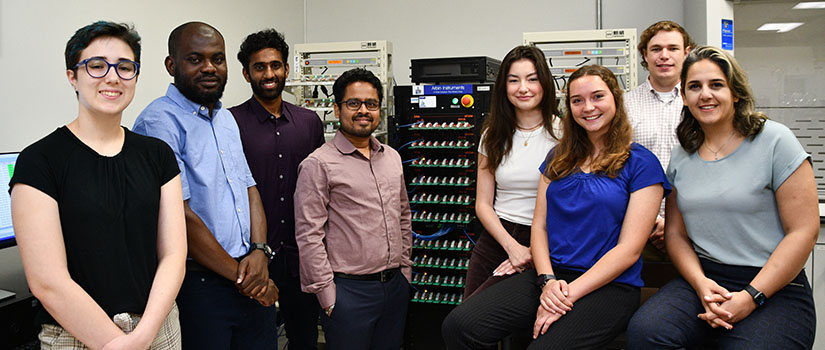Pictured: Assistant Professor Golareh Jalilvand (right) and her research team.
Lithium-ion battery has become the most predominant and fastest-growing energy storage technology. However, existing lithium-ion battery electrode materials have relatively low theoretical capacity. This limits the achievable energy density to 260 watt-hour per kilogram (Wh/kg), which is far below the desired 500 Wh/kg for applications such as heavy-duty vehicles or grid batteries. Since a battery’s energy density is directly related to the capacity of the cathode (positive) and anode (negative) materials, alternative electrode chemistries are indispensable.
Sulfur has received significant attention as a replacement cathode material in lithium-ion batteries and is expected to supply an energy density of more than 500 Wh/kg when coupled with lithium metal anodes. Chemical Engineering Assistant Professor Golareh Jalilvand is one researcher working on this revolutionary energy technology.
Jalilvand is the principal investigator on a $1 million research project funded by NantG Power, a California-based company focused on high-performance lithium-ion battery cell technology. Patrick Soon-Shiong, owner and CEO of Nantworks, the parent company of NantG Power, and Fabio Albano and John Chmiola, are the industrial technical leads on the lithium-sulfur batteries project. While NantG Power works on multiple types of batteries, Jalilvand is leading their lithium-sulfur scientific research as one of the main technologies that the company is pursuing.
Jalilvand is currently in phase two of the project. The first phase focused on understanding the effect of sulfur cathode chemistry and electrode processing method on electrochemical performance, which also succeeded in improving achieved capacity and durability. While the first phase produced promising results with superior performance and several successes for moving to the next level, the testing used coin cells, which are not representative of all practical battery applications.
“Coin cells are ideal for lab scale and research level exploration. However, they do not provide the most accurate representation for practical battery forms, especially for lithium-sulfur batteries,” Jalilvand says. “The work on coin cells in phase one became the foundation of what we're currently doing. Without that knowledge base, our starting point in phase two would have been way off.”
According to Jalilvand, testing with practical form factors is necessary to determine if commercialization is possible. These form factors include cylindrical, prismatic and pouch cells. Jalilvand’s current work focuses on pouch cells, which theoretically has the highest energy density since it has the least amount of waste weight.
“Pouch cells usually have lighter and thinner battery casing than the other forms, which leaves most of the volume and weight of the battery for the energy-providing components,” Jalilvand says.
The current phase of the project has three primary tasks involving the development of new chemistries and structures for cathode and electrolyte. All tasks target transitioning the successes from coin cells to pouch cells.
“We are progressing in all tasks simultaneously and with an impressive pace thanks to the collaborative relationship between USC and NantG Power, as well as the great team of students and postdocs involved in the project,” Jalilvand says.
According to Jalilvand, given that the challenges of batteries grow with their size, she was not expecting the transition from coin to pouch cells to be as fast and successful in phase two. “This fast progress is facilitated by the knowledge foundation we built in phase one,” Jalilvand says.
Jalilvand admits that lithium-sulfur batteries have a lower power density than lithium-ion batteries. This is rooted in the charge and discharge mechanism of lithium-sulfur battery, which is based on a conversion reaction and requires sufficient time to properly operate. While this is less ideal for commuting electric vehicles, it makes lithium-sulfur batteries promising for many other applications that do not require fast charging.
“The best applications will be for heavy-duty trucks, buses and alike that need long discharge time, commonly known as milage, and can be kept overnight at charging stations. Or, for stationary applications such as grid-level energy storage and space applications,” Jalilvand says.
Before starting the project, Jalilvand’s research team had developed an electrode processing method that offered cell durability beyond 1,000 cycles, yet with insufficient achieved capacity. NantG Power invested in the promise and vision of this novel technology. As a result, in the first phase of research, the achieved capacity of lithium-sulfur batteries was doubled, while the loading of sulfur was increased four times than initially used. This motivated NantG Power and Jalilvand’s team to extend their collaboration and take their research into a more practical form factor of battery.
“We have achieved outstanding lithium-sulfur pouch cells with competent energy densities.” Jalilvand says. “I'm looking forward to seeing the long cycle life and durability of our pouch cells because that's the last check mark for us and our industrial partner. With that, it might be time to say we have a lithium-sulfur battery that is ready for commercialization.”
